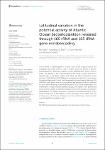Latitudinal variation in the potential activity of Atlantic Ocean bacterioplankton revealed through 16S rRNA and 16S rRNA gene metabarcoding
| dc.contributor.author | Allen, R | |
| dc.contributor.author | Bird, KE | |
| dc.contributor.author | Murrell, JC | |
| dc.contributor.author | Cunliffe, M | |
| dc.date.accessioned | 2023-11-02T19:14:26Z | |
| dc.date.available | 2023-11-02T19:14:26Z | |
| dc.date.issued | 2023 | |
| dc.identifier.issn | 2296-7745 | |
| dc.identifier.issn | 2296-7745 | |
| dc.identifier.other | ARTN 1241333 | |
| dc.identifier.uri | https://pearl.plymouth.ac.uk/handle/10026.1/21566 | |
| dc.description.abstract |
The activities of bacterioplankton sustain open ocean biogeochemical and ecological processes, however, little is known about the activity of specific bacterioplankton, especially related to their biogeography across oceanic scales. The Atlantic is the second largest of the world’s oceans and has an essential role in the global carbon cycle. Here, we show congruence in the structure of 16S rRNA and 16S rRNA gene derived bacterioplankton communities throughout the Atlantic Ocean from temperate to tropical regions. We used 16S rRNA:16S rRNA gene ratios as a phylogenetically resolved proxy for potential activity, demonstrating ocean-scale patterns of putative oligotrophy and copiotrophy in major bacterioplankton groups, with spatial niche partitioning being evident at single-nucleotide resolution within some groups, including the Flavobacteria and SAR86. This study examines the potential structure of the active microbiome of the Atlantic Ocean, providing novel insights into the ecology and life history strategies of both well-known and currently understudied bacterioplankton taxa. | |
| dc.format.extent | 1241333- | |
| dc.publisher | Frontiers Media SA | |
| dc.subject | 16S rRNA | |
| dc.subject | bacterioplankton | |
| dc.subject | biogeography | |
| dc.subject | microbial activity | |
| dc.subject | Atlantic Ocean | |
| dc.title | Latitudinal variation in the potential activity of Atlantic Ocean bacterioplankton revealed through 16S rRNA and 16S rRNA gene metabarcoding | |
| dc.type | journal-article | |
| dc.type | Article | |
| plymouth.author-url | https://www.webofscience.com/api/gateway?GWVersion=2&SrcApp=PARTNER_APP&SrcAuth=LinksAMR&KeyUT=WOS:001057351000001&DestLinkType=FullRecord&DestApp=ALL_WOS&UsrCustomerID=11bb513d99f797142bcfeffcc58ea008 | |
| plymouth.volume | 10 | |
| plymouth.publication-status | Published online | |
| plymouth.journal | Frontiers in Marine Science | |
| dc.identifier.doi | 10.3389/fmars.2023.1241333 | |
| plymouth.organisational-group | |Plymouth | |
| plymouth.organisational-group | |Plymouth|Faculty of Science and Engineering | |
| plymouth.organisational-group | |Plymouth|Faculty of Science and Engineering|School of Biological and Marine Sciences | |
| plymouth.organisational-group | |Plymouth|REF 2021 Researchers by UoA | |
| plymouth.organisational-group | |Plymouth|Users by role | |
| plymouth.organisational-group | |Plymouth|Users by role|Academics | |
| plymouth.organisational-group | |Plymouth|REF 2021 Researchers by UoA|UoA07 Earth Systems and Environmental Sciences | |
| dcterms.dateAccepted | 2023-07-28 | |
| dc.date.updated | 2023-11-02T19:14:26Z | |
| dc.rights.embargodate | 2023-11-4 | |
| dc.identifier.eissn | 2296-7745 | |
| rioxxterms.versionofrecord | 10.3389/fmars.2023.1241333 |


